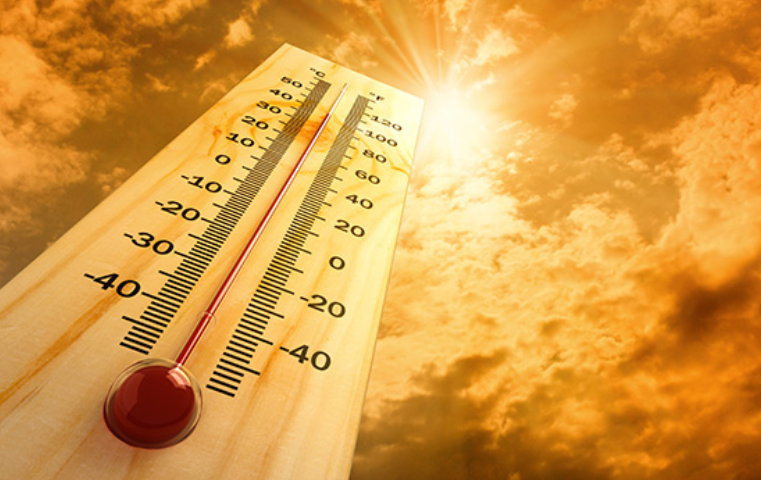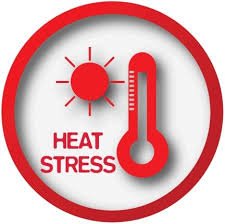Heat stress, We all know that the mercury steadily rises during the summer months. Hence it is essential for all of us to be well aware of possible heat-related problems. The summer season is extremely dry with the weather turning hot and humid resulting into loss of fluids from our body.
Therefore, Associates who are exposed to heat stress suffer from several illnesses causing decreased productivity and increased likelihood of injuries. Heat stress results from a combination of internal body heat production from doing work and external heat exposure from the environment. Both aspects need to be addressed properly in order to control heat stress.
Heat Stress is influenced by several risk factors like climatic conditions, the work environment, demands of the work, clothing and personal characteristics. Demands of work influence the stress on the temperature regulation system. Individual responses to a given work load vary but as an associate expends more energy the body’s internal metabolic heat production rises. This increases stress on the cardiovascular system to regulate body temperature (i.e., by increasing blood flow to skin). Work-related factors that influence heat stress include work rate, level of physical effort, and duration of activity.
There are few simple factors that may affect the heat stress. Clothing characteristics such as insulation, permeability, weight, fit and ventilation affect the body’s ability to regulate internal temperatures. Personal characteristics such as age, weight, previous heat stress injury, underlying medical conditions like diabetes, cardiovascular disorders, chronic pulmonary disease, and thyroid disorders, medication use and overall health and physical fitness contribute to an associate’s susceptibility of contracting a heat-related illness.
Now let us understand heat index & heat stress?
Heat index is the heat that a body feels when temperature and humidity are combined. Heat index is monitored during the summer months. It is calculated by special equipments.Heat Stress is the result of being exposed to high heat index for a period of time. Heat Stress usually occurs when the heat index reaches above the heat index of 32℃ (Celsius).
When the heat index reaches above 32 ℃ (Celsius), administrative controls will be implemented to reduce the likelihood of heat stress-related illnesses.
Hot, humid weather is more uncomfortable than hot, dry weather because high humidity slows the evaporation of sweat which is a natural way of cooling.

Now let us have a look at the heat stress-related illnesses?
The screen shows the occurrence of heat related illnesses if exposed to high heat index for a period of time. Please have a look at the descriptions against each illness.
| Heat Illness | Description |
| Heat Cramps | Painful muscle spasms following hard physical work; can occur during work or rest |
| Heat Rash | Tiny red blisters on the skin and/or a pricking sensation during heat exposure |
| Heat Exhaustion | Sweating; dizziness; fatigue; nausea; vomiting; headache; fainting; rapid pulse; cool, moist skin; pale or flushed complexion; dilated pupils; near normal body temperature |
| Heat Stroke | No sweating (or sweating profusely); hot, dry, red skin, high and rising internal temperature, pupils constricted; mental confusion, loss of consciousness. |
So, how do we prevent heat stress-related illnesses?
For high heat areas that the Site has identified, the heat index is monitored every 2 hours during the summer months.
When these areas reach a heat index above 32℃, the site implements actions to reduce the potential for heat-related illnesses.
The actions to reduce heat stress are communicated to the Associates on the Site Heat Stress Communication board, through mail to managers and announcements to be done through PA system.
The site will ensure that water or electrolyte drinks are readily available for all Associates during period of high temperature.
Usage of exhaust fans reduce temperature substantially.
It is very important for all to get accustomed to high heat environments. Let us examine as to how can they acclimatize themselves?
When a site reaches at or above 32C Heat Index, acclimatization should take place during this time through “Work Hardening.” Work hardening can be achieved by extending the individual normal break schedule for 10 minutes for at least the first 3 days of working on the operations floor. Work hardening is important because we want to ensure that new Associates have adequate resting time which gives the body an opportunity to get rid of excess heat, slow down the production of internal body heat and permit greater blood flow.
This extended break should not be used to go to the washroom, break room, or smoking area, rather Associates should limit these extended breaks in resting in a cool area and drinking lot of fluids.
Do you know what are the expected safe behaviors? Lets have a look.
- Alert your superior if you are experiencing symptoms of heat-related illnesses.
- Follow the heat stress reduction plan when posted.
- Stay hydrated.
So, we have now understood about heat stress and prevention for various heat stress related illnesses.
Let us now quickly sum up about the various protection measures:
Precautions:-
- #Stay fit
- #When possible, avoid working in hot areas and in full sun
- #Take frequent breaks
- #Cover up with long-sleeve shirt, hat
- #Increase fluid intake
- #Avoid alcohol and excessive caffeine
- #Reduce activity when exposed to heat
- #Use buddy system to watch for symptoms
All these measures will help you to overcome problems arising out of heat stress.
Thank you for taking interest. Stay fit and stay healthy.
Read more:- https://www.unveil.press/want-to-get-rid-of-some-unnecessary-weight/












































